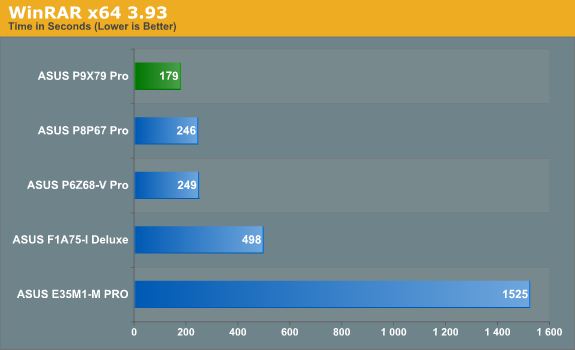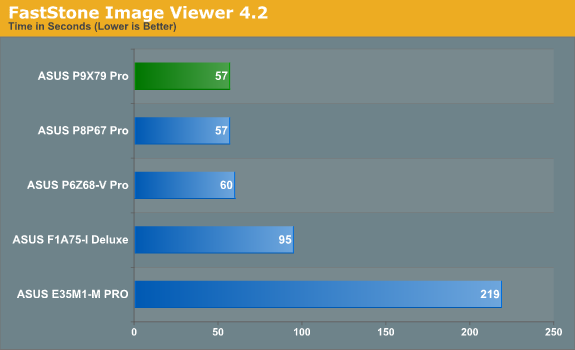Sandy Bridge-E and X79 – The ASUS P9X79 PRO Review
by Ian Cutress on November 14, 2011 3:01 AM EST- Posted in
- Motherboards
- Asus
- X79
3D Movement Algorithm Test
The algorithms in 3DPM employ both uniform random number generation or normal distribution random number generation, and vary in various amounts of trigonometric operations, conditional statements, generation and rejection, fused operations, etc. The benchmark runs through six algorithms for a specified number of particles and steps, and calculates the speed of each algorithm, then sums them all for a final score. This is an example of a real world situation that a computational scientist may find themselves in, rather than a pure synthetic benchmark. The benchmark is also parallel between particles simulated, and we test the single thread performance as well as the multi-threaded performance.


As expected, due to the 3960X, we have a clear lead on 3DPM. In single thread mode, we have a 3.9 GHz core taking top place, and the power of 12 threads at 3.6 GHz in multithreaded mode shows in the 914.76 score.
WinRAR x64 3.93 - link
With 64-bit WinRAR, we compress the set of files used in the USB speed tests. WinRAR x64 3.93 attempts to use multithreading when possible.

The more cores and threads for WinRar also play a role in providing some excellent times in comparison to other chipsets.
FastStone Image Viewer 4.2 - link
FastStone Image Viewer is a free piece of software I have been using for quite a few years now. It allows quick viewing of flat images, as well as resizing, changing color depth, adding simple text or simple filters. It also has a bulk image conversion tool, which we use here. The software currently operates only in single-thread mode, which should change in later versions of the software. For this test, we convert a series of 170 files, of various resolutions, dimensions and types (of a total size of 163MB), all to the .gif format of 640x480 dimensions.

In this single threaded workload, no real difference is seen compared to P67, showing that for FastStone, memory is not a limiting factor, and the move to SB-E doesn't make much of a difference.
Sorenson Squeeze 6.0 - link
Sorenson Squeeze is a professional video encoder, complete with a vast array of options. For this test, we convert 32 HD videos, each a minute long and approximately 42 MB in size, to WMV 512KBps format. Squeeze can encode multiple videos at once, one for each thread.

With Squeeze being a fully multithreaded test, we're comparing a 4 thread i5-2500K to a 12 thread 3960X, so it's no wonder that the 3960X comes out on top.










55 Comments
View All Comments
mailman65er - Monday, November 14, 2011 - link
No SSD Caching (no intel RST)?Just get a Synapse Cache SSD - the included Dataplex cache software outperforms Intel caching anyway... No problem.
jmelgaard - Tuesday, November 15, 2011 - link
Pft... Who needs SSD caching anyways?!?...I have more than enough space on my 3x240GB Vertex 3 + 2x120GB Vertex 2 + 80GB Intel X25-M r2.
:P...
ASUSTechMKT - Wednesday, November 16, 2011 - link
LOL you are lucky man. Keep in mind though you do get to maintain Trim in SSD Caching but while not in raid.kvanje - Monday, November 14, 2011 - link
Tom's just showed in a test that Skyrim becomes CPU-bound at a certain point, so that might make a good addition to your benchmarks in this case.ts1973 - Monday, November 14, 2011 - link
Why no comparison with another X16-X16 Intel platform, most notably the X58-990X combo ? Gaming tests and value for possible upgrade are not very convincing this way.futurepastnow - Monday, November 14, 2011 - link
Will Sandy Bridge -EP Xeon processors work in X79 desktop motherboards?ASUSTechMKT - Monday, November 14, 2011 - link
Our P9X79 WS is qualified to support Xeon series CPUs. Other baords may potentially offer microcode support but will not be officially validated for use with Xeon CPUs.ven - Monday, November 14, 2011 - link
still relying on heat sinks,heat pipes and fans I expected some change from the board manufactures for this platform at least from you Asus,Disappointed......... Please move Forward & show us the glimpse of the future cooling technologies .And also why intel has downgraded from QPI to DMI ,yes of course PCIe lanes are moved to Processor but for this is such a high end & pricy platform QPI should have opted.
Great work Asus Iam fan of your color theme and UEFI implementation.Board looks great. At present proud owner of Maximus iv Gene-Z, Iam waiting for some mATX boards
ASUSTechMKT - Monday, November 14, 2011 - link
We are always looking into other aspects in regards to cooling / dissipation technologies. Thanks for the feedback depending on certain factors more advanced technologies can considerably increase cost or time to produce ( Such as when we used CeraM!X on our TUF series motherboard. Regardless we look for other aspects to improve upon such as more advanced and efficient VRM designs with more options on temperature and current handling or loading.Thanks for the great feedback it is appreciated and watch out soon on the MATX front!
alpha754293 - Monday, November 14, 2011 - link
If populating all 8 DIMMS is going to drop it down to DDR3-1333 speeds, that means that you can just BUY DDR3-1333 8 GB DIMMs for as little as $75 a pop (and that's ECC Registered server RAM too!). That means for a system with 64 GB, you're only look at $600, which is almost $300 less than the top-of-the-line (currently, at launch) SNB-E processor you can buy."There are issues to the memory that a lot of people will consider – does anyone ever need 64 GB of memory? Even if it were populated with relatively cheaper 4 GB sticks, does anyone ever need 32 GB of memory?"
With memory being relatively cheap these days, would most people "need" it? No, you're right, probably not.
But if I can get a 32 GB super fast RAM drive, that extra $300 might be worth it. If you have a game or two that's ridiculously large and takes a fair bit of time to load, the RAM drive would be well served. Or if you start/restart large apps (like Photoshop CS5) often; again, the RAM drive could come in handy.
And when you can have that much memory for less than the cost of the processor, it's worth considering -- IF you can use it.